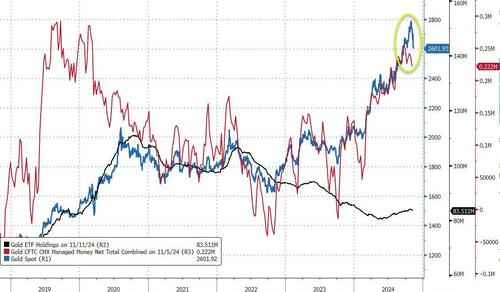By Benjamin Picton, senior macro strategist at Rabobank
To The Moon!
Another day, another record close for the S&P500. The 51st of 2024, to be exact. Even European stocks got in on the act yesterday, with the EuroStoxx 50 closing 1.07% higher, the FTSE100 up 0.65% and the German DAX +1.21%. There are also signs that the rally continues to broaden out from the usual mega-cap tech leadership. The Russell 2000 rose by 1.47% to sit just shy of the November 2021 highs and the MSCI US Banks Index is now up more than 38% YTD.
An extension of the risk-on rally in stocks is certainly nice for pension fund balances, but the most impressive price action of the day was to be found in Bitcoin. In yesterday’s note I commented on Bitcoin breaking the $80k barrier over the weekend, but the gains kept running throughout the trading day to the extent that the $89k level has now been taken out.
While ‘digital gold’ has been on a tear, regular gold fell by as much as 2.6% yesterday to be trading just over $2,600/oz. There is perhaps an element of profit taking here after the yellow metal’s stellar run over the course of 2024, but gold is also being weighed down by a strengthening US Dollar (up another 0.5% on the DXY yesterday) and ETF outflows to fund Bitcoin purchases. CFTC data confirms that speculators have cut their net long position in gold to the lowest in 12 weeks, despite the promise of bigger deficits and inflationary tariff policies from President Trump.
US bond markets were closed for Veterans Day (Armistice Day) yesterday, so there was no price action in Treasuries. German Bunds exhibited very minor bull steepening on the 2s10s as 2-year yields fell by 4.7bps and 10-year yields dropped by 4bps. Gilts exhibited a similar pattern of minor bull steepening, but the overall fall in yields was slightly less pronounced in the UK, perhaps owing to the ongoing reaction to Chancellor Reeves’ big tax and spend budget.
The Bloomberg commodities index fell by almost 1% yesterday to extend losses for a second-straight day. Brent crude was down by 2.76% to $71.83/bbl and WTI fell even more sharply, down 3.27% to $66.08/bbl. Perhaps Donald Trump’s vocal support of “drill, baby, drill!” explains the relative price action there, while the overall weakness in crude pricing is likely an amalgam of continued market oversupply, underwhelming stimulus in China and heightened expectation that Trump’s election victory could see a deal brokered to end the war in Ukraine.
A forced resolution to the war in Ukraine would be very controversial. An apparent example of misinformation was circulating X yesterday claiming that NATO Secretary General Mark Rutte had said that he would “personally expel” the United States from the alliance if Trump did a deal to surrender Ukraine to Russia. Fact checkers from Newsweek and the BBC have found no such comments from Rutte, but the speed at which the rumor spread is indicative of how sensitive these matters are and that nothing (no matter how fanciful) should be completely disregarded as outside the realms of possibility in the current environment.
The FT reports today that Emmanuel Macron and Keir Starmer have pledged “unwavering” support to Ukraine, while the EU is set to redirect “tens of billions” of euros from ‘cohesion funds’ designed to reduce economic inequality between member states to defence and security spending initiatives. Donald Trump has been vocal in his criticisms of European free-riding on the US defence apparatus and has suggested that he will be pressuring EU leaders to spend 3% of GDP on their own security, a number that most member states (Poland, the Baltic states and Greece being notable exceptions) currently fall well short of. Meanwhile, the Wall Street Journal reports that Trump has just selected China hawk, NATO critic and former Green Beret Mike Waltz as White House National Security Advisor, an important role that coordinates policy across multiple government agencies and does not require Senate confirmation.
While the Trump trade continues to roll through markets and give European allies sleepless nights, there are some signs of economic improvement in the antipodes. An official from the New Zealand Treasury this morning observed that “second-tier data suggests that the economy is turning up”, while October consumer confidence figures for Australia recorded a big surge that saw the ‘economic situation in the next 12 months’ and ‘family finances next 12 months’ sub-indices surge into net optimistic territory.
Futures implied terminal policy rates for Australia and New Zealand have moved markedly higher over the last month or so. OIS futures now suggest fewer than two 25bps policy rate cuts in Australia by the end of next year (previously more than three) and a terminal OCR in New Zealand of 3.36% by end 2025 after previously pricing in a sub-3% figure in early October. RaboResearch is now slightly more dovish than the market pricing in both cases. We see a 3.6% cash rate in Australia by August next year and a 3.25% OCR in New Zealand (a comparatively hawkish number when we first published it!).
Ultimately, the path of policy rates at the bottom of the world will depend a great deal on the Chinese response to Trump tariffs. Tradeable inflation may be higher in the short term as goods get sucked into the USA ahead of the imposition of universal tariffs, but then lower once the tariffs come into effect and exporters seek to dump goods into markets that remain open to them. On a long-term structural basis, inflation is likely to be higher as global production and distribution increasingly emphasises security over efficiency. Combine that with the potential for Dollar strength to continue and the prospect for swingeing rate cuts in the antipodes suddenly looks limited.
